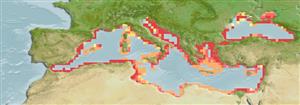Common names from other countries
>
Gobiiformes (Gobies) >
Gobiidae (Gobies) > Gobiinae
Etymology: Chromogobius: Greek, chromis = a fish, perhaps a perch + Latin, gobius = gudgeon (Ref. 45335).
More on author: Steindachner.
Environment: milieu / climate zone / depth range / distribution range
Ecologia
marinhas demersal. Subtropical; 47°N - 30°N, 6°W - 42°E
Mediterranean Sea and Black Sea.
Tamanho / Peso / Idade
Maturity: Lm ? range ? - ? cm
Max length : 6.6 cm SL macho/indeterminado; (Ref. 4696)
Anterior opercle with a dark spot on its lower edge. Anterior margin of pectoral fin base with a dark vertical band. Scales cycloid. Sensory papillae: row 1, 13-20; row 2, 11-19; row 3, 9-16; row 4, 10-16; row 5, 7-16; row y, 3-7; row tr, 4-7 (Ref. 41100).
Adults occur in shallow inshore waters, under stones or between weed tufts. Also found in mid-tide pools. Feed on small decapods and amphipod crustaceans (Ref. 4696). Eggs are pear-shaped (Ref. 4696).
Life cycle and mating behavior
Maturidade | Reprodução | Desova | Ovos | Fecundidade | Larvas
Miller, P.J., 1986. Gobiidae. p. 1019-1085. In P.J.P. Whitehead, M.-L. Bauchot, J.-C. Hureau, J. Nielsen and E. Tortonese (eds.) Fishes of the North-eastern Atlantic and the Mediterranean. Volume 3. UNESCO, Paris. (Ref. 4696)
Categoria na Lista Vermelha da IUCN (Ref. 130435)
CITES (Ref. 128078)
Not Evaluated
Ameaça para o homem
Harmless
Utilização humana
Mais informação
ReferênciasAquaculturaPerfil para aquaculturaEstirpesGenéticaElectrophoresesHereditariedadeDoençasProcessamentoMass conversion
ColaboradoresFotografiasStamps, Coins Misc.SonsCiguateraVelocidadeTipo de nataçãoÁrea branquialOutras referênciasCérebrosVisão
Ferramentas
Relatórios especiais
Descarregue XML
Fontes da internet
Estimates based on models
Preferred temperature (Ref.
115969): 13 - 21.6, mean 18.1 (based on 174 cells).
Phylogenetic diversity index (Ref.
82804): PD
50 = 0.6250 [Uniqueness, from 0.5 = low to 2.0 = high].
Bayesian length-weight: a=0.00708 (0.00333 - 0.01504), b=3.09 (2.92 - 3.26), in cm Total Length, based on LWR estimates for this (Sub)family-body shape (Ref.
93245).
Nível Trófico (Ref.
69278): 3.4 ±0.52 se; based on food items.
Resiliência (Ref.
120179): Elevada, tempo mínimo de duplicação da população menor que 15 meses (Preliminary K or Fecundity.).
Fishing Vulnerability (Ref.
59153): Low vulnerability (10 of 100).
